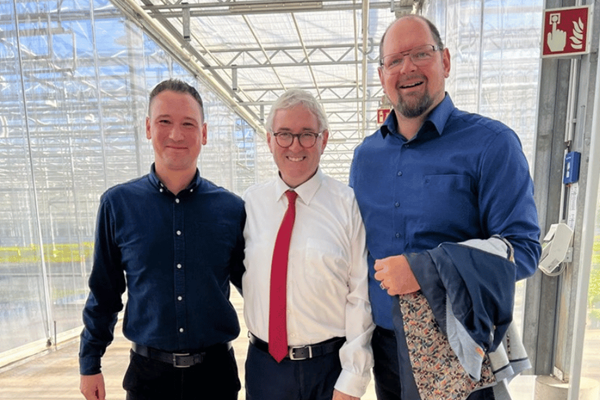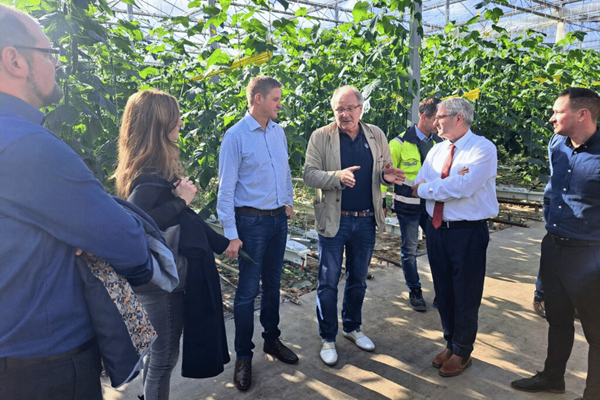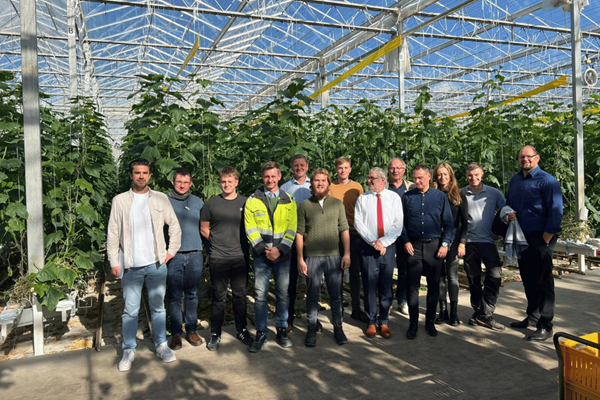The high-tech greenhouse of the Bördegarten company in Osterweddingen will soon be twice as large as before. At present, vegetables and organic herbs are grown on an area of around 64,000 square meters just outside Magdeburg. "Now we have started planning an extension of a further 63,000 square meters. The new greenhouse will be built directly on the eastern side of the existing greenhouse and we will then also manage it as a single unit. In a first step, we have drawn up the specifications for the areas of horticulture, greenhouse construction, energy and sustainability", says Michael Tepfer, Head of Strategic Corporate Development at the Wimex Group, to which Bördegarten belongs. "We are being supported in the planning by eight master's students from the Dresden University of Applied Sciences (HTW) under the direction of Professor Fritz-Gerald Schröder", he adds.
Martin Stichnoth, district administrator of the district of Börde, Dr. Jürgen Ude, state secretary in the state chancellery of Saxony-Anhalt, and Daniel Krake, representative of the district administrator of Anhalt-Bitterfeld, were also present at the first working meeting between Bördegarten and HTW Dresden to find out more about the project.
 Martin Stichnoth (right), district administrator of the district of Börde, Dr. Jürgen Ude (center), state secretary in the state chancellery of Saxony-Anhalt, and Daniel Krake, representative of the district administrator of Anhalt-Bitterfeld, visited the site to learn about the new greenhouse project.
Martin Stichnoth (right), district administrator of the district of Börde, Dr. Jürgen Ude (center), state secretary in the state chancellery of Saxony-Anhalt, and Daniel Krake, representative of the district administrator of Anhalt-Bitterfeld, visited the site to learn about the new greenhouse project.
Creating and securing local jobs
"In technical terms, the new greenhouse should be another ten years ahead of the existing one," emphasizes Michael Tepfer. "The most striking feature will be that it is built around three meters higher – and does not need ventilation flaps. The 'old building' still has 3,200 of these, which are used for climate control." The lack of ventilation flaps means that the new building is even better protected against the entry of pests or the penetration of unwanted substances. "In addition, the heating concept will be significantly more effective, so that each kilowatt hour of energy will be used even more sustainably," explains Michael Tepfer. To ensure a sustainable supply for the greenhouse, Bördegarten also wants to use the waste heat from the waste gas stream of the neighboring company AGC Glas.
The new greenhouse will be used primarily to grow cucumbers for various retail chains. "This will strengthen our position as a producer of cucumbers for regional food retailers and thus also secure local jobs," emphasizes Michael Tepfer. "In addition, the new building will enable us to work even more efficiently in terms of energy in our production." In addition to around 3.3 million pots of organic herbs such as parsley, basil, chives, rosemary, dill and mint, up to 50,000 cucumbers are harvested each day in the existing greenhouse. Thanks to the resource-efficient, high-tech supply of light, heat, fertilizer and drip irrigation, the Osterweddingen cucumbers bind more CO₂ during their growth than is produced by their cultivation. This means that Bördegarten's cucumber production currently saves the environment around 919 tons of the climate-damaging greenhouse gas every year. The expansion of the area is expected to double the CO₂ savings.
 Professor Fritz-Gerald Schröder (center) from the Dresden University of Applied Sciences (HTW) with State Secretary Dr. Jürgen Ude (right) and Michael Tepfer (to Professor Schröder's left), Head of Strategic Corporate Development at the Wimex Group, in the current Bördegarten greenhouse.
Professor Fritz-Gerald Schröder (center) from the Dresden University of Applied Sciences (HTW) with State Secretary Dr. Jürgen Ude (right) and Michael Tepfer (to Professor Schröder's left), Head of Strategic Corporate Development at the Wimex Group, in the current Bördegarten greenhouse.
The connection from the region to the university
Eight master's students from the horticulture department at the HTW in Dresden are involved in the construction project. They are planning the new greenhouse according to Bördegarten's specifications and under the direction of Prof. Fritz-Gerald Schröder – as a study assignment. "The group of students has now received the first assignment during a kick-off meeting," says Michael Tepfer. Two more working meetings are planned for the next few weeks to adjust the project content and for an intensive exchange of ideas. In February, the students will present the results of their work. "Then we will be able to assess whether the concept has any economic prospects. This also depends on whether we can purchase the affordable energy from AGC Glass in the long term," says Michael Tepfer. If the investment decision is positive, the construction of the greenhouse extension is planned for 2025/2026. The total costs will amount to around ten million euros.
 At At the kick-off event for the extension in the Bördegarten Greenhouse: the planning group of master's students from the HTW Dresden with the visitors from politics and the Wimex Group management.
At At the kick-off event for the extension in the Bördegarten Greenhouse: the planning group of master's students from the HTW Dresden with the visitors from politics and the Wimex Group management.
One of the students was the link between Bördegarten and the HTW. "Ludwig Schulenburg is from the Magdeburg region, has an employment contract with us in the greenhouse and is simultaneously studying horticulture with Prof. Schröder in Dresden," explains Michael Tepfer. "In his study-free periods, he works with us in the harsh practical environment, brings theoretical knowledge from Dresden and then returns to the university with practical questions. If our joint plan works out, Ludwig will be the first horticultural engineer of the next generation."
Source: wimex-group
